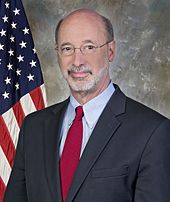The following is the latest COVID-19 information from the state government as 2:00 p.m. on Tuesday, December 22.
Governor Wolf
 Last week the Governor’s Budget Office released a mid-year budget report. The report noted that the state ended the 2019-2020 fiscal year with a $2.7 billion deficit largely due to the COVID-19 pandemic. For the second half of the fiscal year the administration projects that economic growth will rebound slightly due to low interest rates, short-term fiscal policies, and a declining unemployment rate. The mid-year budget report also highlighted areas of concern moving forward, including the uncertainty of the impact of COVID-19 on state revenue, the replacement of one-time funding sources, and the unknown potential of additional federal stimulus funding. The administration will deliver its fiscal year 2021-2022 budget proposal on February 2nd.
Last week the Governor’s Budget Office released a mid-year budget report. The report noted that the state ended the 2019-2020 fiscal year with a $2.7 billion deficit largely due to the COVID-19 pandemic. For the second half of the fiscal year the administration projects that economic growth will rebound slightly due to low interest rates, short-term fiscal policies, and a declining unemployment rate. The mid-year budget report also highlighted areas of concern moving forward, including the uncertainty of the impact of COVID-19 on state revenue, the replacement of one-time funding sources, and the unknown potential of additional federal stimulus funding. The administration will deliver its fiscal year 2021-2022 budget proposal on February 2nd.
Department of Health
- The Department of Health has published guidance for responding to signs and symptoms among health care workers after they receive COVID-19 vaccinations.
- The Department of Health issued an order calling for vaccine providers to report data related to each administration of an immunization for COVID-19 through the Pennsylvania Statewide Immunization Information System.
- The Department of Health has posted infection prevention and control considerations for residents of long-term-care facilities who show signs and symptoms following COVID-19 vaccination.
 Department of Health – by the numbers
Department of Health – by the numbers
- Pennsylvania’s number of new daily COVID-19 cases remains exceptionally high but has declined during the past three days.
- The state’s total number of COVID-19 cases today surpassed 560,000. Thirty-seven percent of those cases have been diagnosed this month alone.
- The number of new daily COVID-19 deaths remains exceptionally high and is not declining. Today the state surpassed 14,000 deaths since the beginning of the pandemic and more than 25 percent of those deaths have been this month.
- Nearly 6200 Pennsylvanians are currently hospitalized with COVID-19. That is more than twice the number of people hospitalized during the peak of the crisis in the spring.
- The state’s positivity rate on COVID-19 tests fell from 16.2 percent two weeks ago to 15.8 percent last week.
- More than 57,000 residents and employees of long-term-care facilities have contracted COVID-19. That encompasses 1433 facilities in all 67 counties.
- Nearly 18,000 health care workers have now contracted the virus.
- According to the state’s COVID-19 early warning monitoring dashboard, every county in the state except Sullivan County now has a positivity rate greater than five percent. In the past, Department of Health Secretary Levine has referred to anything greater than five percent as “concerning.”
- All 67 Pennsylvania counties are now, according to the Department of Health, in “substantial levels of community transmission.”
- Among young people from the ages of five through 18, there have been more than 44,000 cases of COVID-19 since the start of the pandemic. Twenty-seven percent of those cases have occurred in the past two weeks.
Department of Human Services
DHS’s Office of Developmental Programs has released temporary closure guidance to Older Adult Daily Living Centers, Structured Day Programs, LIFE Day Centers, Adult Training Facilities and Vocational Facilities related to the community spread of COVID-19 or when an individual or staff member is diagnosed with COVID-19 and spent 15 minutes or more in the facility within a 24-hour period starting from two days before illness onset (or, for asymptomatic patients, two days prior to test specimen collection) until the time the person is isolated. This announcement also describes the process for re-opening facilities using DHS’s Community Participation Support and Older Adult Facility Reopening Tool. Find the announcement here.
DHS’s Office of Developmental Programs policy states that staff members can administer medications to individuals if the staff person successfully completes an ODP-approved medication administration course. Due to the COVID-19 pandemic, ODP permitted staff who are required to take the Standard Medication Administration Training Course to take the Modified Medication Training Course until December 31, 2020. Because the pandemic continues, staff may still take the modified course in place of the standard course until June 30, 2021. Go here to see the policy statement and learn more about certain conditions under which it applies.
 Department of State
Department of State
- The Department of State has authorized chiropractors, dentists, optometrists, pharmacists, and podiatrists to order and administer COVID-19 tests if they have been issued a clinical lab permit from the Pennsylvania Department of Health to conduct diagnostic lab testing. See the department’s announcement of this policy, which will remain in effect for the duration of the governor’s emergency declaration and an additional 90 days.
- The Department of State has extended its March 2020 waiver temporarily suspending the requirement that pharmacists with active Authorizations to Administer Injectables maintain active certifications in cardiopulmonary resuscitation. Pursuant to that waiver, if a pharmacist held a valid CPR certificate on March 17, 2020, the State Board of Pharmacy has treated that certification as valid through December 31, 2020. As long as a pharmacist held a CPR certificate that was valid on March 17, 2020, such certification will be accepted by the board as valid through March 31, 2021. Pharmacists who fall within this group may take an online CPR training class in lieu of in-person training to enable them to renew their CPR certification prior to the new, extended deadline of March 31, 2021. This does not affect the current biennial renewals for pharmacists and for authorizations to administer injectables. Those renewals are still due by December 29, 2020.
- The Department of State has issued a 90-day extension of the December 31, 2020 renewal deadline for licensees under the State Board of Medicine. These licenses will remain active until March 31, 2021. In addition, emergency temporary licenses granted to licensed practitioners in other states and jurisdictions have been extended from their current expiration date of December 31, 2020 to June 30, 2021. If an individual already holds an emergency temporary license but is unable to meet all requirements for full licensure by December 31, 2020, that individual may continue to practice in Pennsylvania after December 31, 2020 until the next expiration date of June 30, 2021.
Around the State
- The Harrisburg Patriot-News has published an interactive map with a county-by-county breakdown of COVID-19 cases in Pennsylvania since the start of the pandemic.
- The Johnstown Tribune-Democrat, citing data collected by the New York Times, reported that Pennsylvania’s Cambria County “…led the nation in new cases per capita over the past two weeks – among counties with populations of 100,000 or more people.”
- COVID-19 is posing increasing staffing challenges for nursing homes in southwestern Pennsylvania according to a Pittsburgh Tribune-Review report that tells of one nursing home company where the situation “…is so dire that roughly a dozen corporate office workers have been trained as temporary nurse aides. Employees who were formerly nurses have jumped in to help, picking up overnight and back-to-back shifts when spates of employees got sick or quarantined at home,” adding that “…at least 372 of the chain’s roughly 1,500 staffers – or nearly 1 in 4 – have contracted covid-19.” The article also tells of facilities’ extensive use of staffing agencies to fill positions.
- Westmoreland County Commissioner Gina Cerilli has tested positive for COVID-19, according to the Latrobe Bulletin. This means all three of the county’s commissioners have contracted the virus; two remain under quarantine.
- The Philadelphia Business Journal reported on the city of Philadelphia’s plans for distributing and administering COVID-19 vaccines.
Resources to Consult
Pennsylvania Department of Human Services
Pennsylvania Department of Health
Centers for Disease Control and Prevention